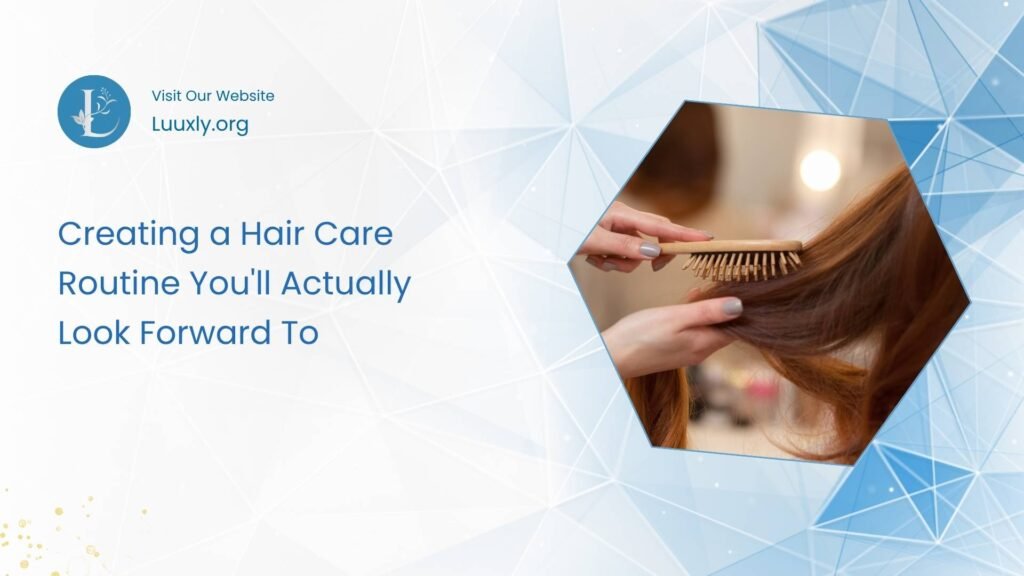
The average person approaches hair care like brushing their teeth – get in, get out, make it as quick as possible. But realistically, when done right, washing and caring for hair can become that small daily repetitive task that feels good. Not good in the way of “I deserve a treatment at a spa” good (although that’s nice), but in the “I’m doing something right” good.
The difference between a task and a self-care experience comes from a few variables. And no, you don’t need an hour-long time period or a full bathroom of products to achieve either.
Why Most Hair Routines Feel Like Work
Hair routines revolve around what people think they should be doing, but then those expectations fall flat. People buy products based on scent or marketing allure, give them three weeks’ worth of time, see minimal results, and toss out the bottles in the endless cycle of attempting to find what’s right. It becomes tedious.
Instead, it’s not always about dedication to use or technique. Most products just do nothing.
And when hair care products are fillers, synthetic fragrances, and what seems like attempts to get things covered but not improved, that’s what happens. Hair might look nice styled on Wednesday night, but by Thursday morning, it wants to go back to its natural state: dryness, splits, frizz. But with no real changes observed over time with effort, it’s hard to engage consistently.
This is where quality of ingredients plays a role – but not in an elitist manner – more of a “this actually does something” manner. When botanical ingredients are used for their nutrient density, products work differently since they’re giving hair what it can use. Companies like Max Green Alchemy operate on this premise; their formulation approach stems from using active ingredients over fillers. While people may feel and see results sooner, it’s because they’re actually addressing what’s needed rather than massaging product around for the fun of it.
The Basics Before Fancy Fixes
Before considering the minutia that may require step optimization or additional treatment steps, get the basics down first. A routine we want to repeat has three major components: something cleansing that won’t strip, something to put moisture back into hair and something to protect.
For most people, that’s it. The rest is icing on the cake.
The cleanser is most important because it’s the framework for what’s intended next. Sulfates create that gratifying lather we learned to appreciate in childhood. Still, they also work too well at stripping natural oils at the scalp, making hair harder to manage on day 2 unless hours of styling are involved. Milder cleaners (and many of them are plant-based) will clean without the squeaky-clean feel. When hair isn’t attempting to get over a hangover from over-cleansing with aggressive agents, it becomes more malleable and easier to maintain between washes.
Second is moisture. Here is where people get it wrong (too little or too much). Hair requires water and something to help retain the water. This means adding conditioners, leave-in conditioners or very light oils. The trick is matching the intensity with hair type; fine hair requires much less than thick or textured hair that can take a richer approach.
The third factor is protection. This is what most people forget. From heat styling to sun exposure and sweat (and general friction caused by pillows and brushing), hair can take a beating. A light protective (cream/oil/spray) goes a long way to take 20 seconds at most but prevents cumulative damage that makes hair feel like straw over time.
How To Make It Feel Like Self-Care
The mentality shift occurs once results become visible. Still, you can make it worthwhile along the way by focusing on the experience.
Make sure there’s scent involved you genuinely like. Not overwhelming scents – but nice enough so you want to inhale deeply (and less artificial). Natural scents come from natural essential oils which smell more nuanced rather than synthetic chemical levels. This may seem irrelevant until you realize you’re going to be inhaling whatever scent you’ve decided upon multiple times per week forevermore.
Second is temperature. Most people wash their hair in water far too hot because it feels good in the moment. But hot water strips cuticle and raises it (thus creating frizz and dryness). Warm temperatures clean equally as well without all the damage caused. A final cool rinse at the end – even 30 seconds – can seal in cuticle and help hairs look shinier; it’s an uncomfortable moment but well worth it.
Third? Give yourself enough time, if you’re rushing through care of any kind for your hair – from washing to styling – you’ll feel disappointed every time it’s something on your schedule. If mornings are too hectic, wash your hair at night. If evenings are too busy, make it a weekend morning ritual. When it’s not sandwiched between a dozen other tasks, it becomes feasible and almost enjoyable instead of merely bearable.
The Upgrade That Changes Everything
At some point in the life cycle of everyone’s hair, they realize what’s fine but not great exists – it’s manageable enough but requires hours’ worth of styling (and third-day appearance is baggy). It looks fine but never falls into place without additional daily work.
This usually means time to upgrade product quality instead of layering on more products/steps. One really good cleanser beats three mediocre ones any day. One good treatment once a week does more than five different products each day.
Here’s how to know: when ingredient lists don’t begin with water and thickeners but instead recognizable plant extracts, oils or botanicals; when they feel concentrated and not watered down; when less means more because you have enough in a container (this usually renders the cost-effective options with higher upfront costs null and void).
Especially lately, the hair industry has gotten better at this. More brands focus on effective products made from ingredients that don’t skimp on efficacy or what’s going onto your body. The key indicators come 3-4 weeks later when hair acts differently over time than initially looking good for a few hours after styling.
Creating Your Actual Routine
Most people benefit from washing their hair 2-4 times/week depending on their scalp oil production and general lifestyle behavior surrounding sweat activity. Therefore, a typical routine on the days one needs to wash includes:
Thoroughly wetting all hair with warm/hot water while washing your body simultaneously (especially if working out) – a great way to get things done in one go! Then apply cleanser with more emphasis on the scalp – this is where oil and dirt build up. Rub in for 1 minute minimum (this feels good/soothes/scalp increases blood flow in follicles) – and rinse thoroughly.
Conditioner/treatment should be applied mid-length down through ends and left in for 2-3 minutes while doing other shower rituals (unless it’s an extensive treatment). This should be rinsed in cooler water (to seal cuticle) before exiting the shower.
Once done, squeeze water out gently (no rubbing with a towel – a recipe for frizz), add whatever protective/styling product works best for your regimen (that doesn’t have oil) and either airdry (the best option) or plug in heat tools as needed.
On non-wash days, it’s even simpler: sometimes dry shampoo if needed or scalp refresher might suffice; light oil on ends if they’re feeling dry works well too; otherwise, brushing through is almost all that’s needed!
When You Start Seeing Changes
Generally speaking, within 3 weeks good products and good regimes create results: holding styles better because cuticle lies flatter; less frizz unless that’s the goal; less extremity on both sides – scalps calm down more; split ends don’t necessarily proliferate as often as they appear if they’re unnecessary (they become clear where they’re necessary when there’s breakage).
Results compound over time: there is nothing better for someone who’s retained great practices for 3 months vs 3 years – it acts different – is lighter weight – has more natural movement – response to styling gets better – less efforts go into making it look good day-to-day without requiring extensive refactoring.
This is when it switches from not feeling entitled to taking ownership of doing so because guess what? You’re doing something right – which makes complete sense because when you take care of something and see improvements – a little here and there – is great!
The Long Game
Most importantly, it’s not about things looking perfect tomorrow; it’s about consistently getting better with time – especially now that you have a system that keeps everything going! The better positioned condition of your hairs substructure gets established from consistent growth – easier maintenance – fewer styling options looks good even without effort unless it’s a bad hair day!
The best systems are once sustainable enough that you can maintain them long-term – the products that work become part of what’s worked! They don’t feel overwhelming – they become second nature because you’ve accepted the results as worthwhile and continue to do so!
When that all works – with functional hairstyles over time – it becomes one more viable daily task that makes life just that much better – a ten-minute endeavor that somehow makes every day after feel exponentially better!



